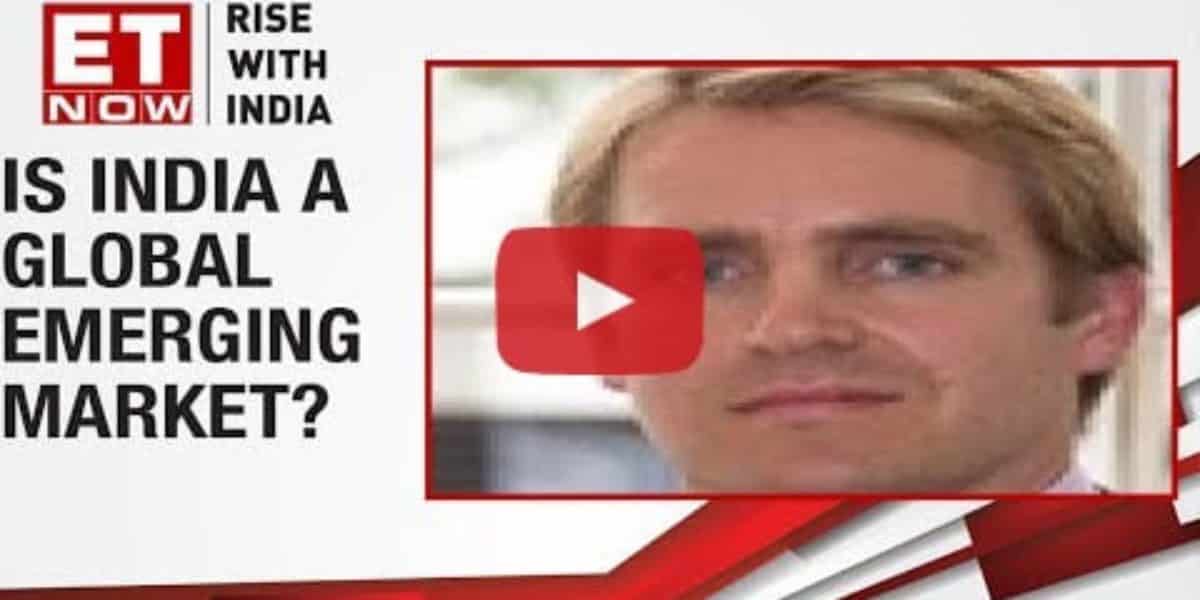We are overweight on China but India is coming up: Eric Anderson, Milltrust Global EMs
“There are two ways to make money in EMs – picking the right stock and picking the right country.”
According to one-year forward valuations, India trading 50% over the EM average and 20% over the long-term India average, said Eric Anderson, Senior Portfolio Manager on the Global Emerging Markets Strategies and Head of Investment Solution, Milltrust Global EMs, in an interview with ETNOW. In our view, medium to long term, flows are going to wait and see what happens next., says Anderson
What is your outlook for India within the global emerging markets portfolio?
We have moved up our exposure to neutral. We have been underweight for a number of reasons. Typically, we have a shorter term view on Indian markets. We look at six to nine months, which I guess is more of a medium term. We look at a number of factors when evaluating the countries. From India’s perspective, what has worked well is that you have improving sentiments following the Modi victory which will translate into positive equity markets and an accommodative monetary policy.
You have a growth trending above policy rate, above the inflation rate and a positive terms of trade. All those are generally positive for equity markets and that is a good start of the equation. The more challenging one and the reason we are still neutral is that valuations are a little bit high from both absolute and relative basis. If you look at the one-year forward valuations, you are trading 50% over the EM average and 20% over the long-term India average.
The return of equities dipped a bit below the EM average and the dividend yield was a bit low. There are still some better opportunities elsewhere in EM. While we have an improving outlook, we are still neutral. What we look to go overweight is when we see improvement on the valuations and that will come from earnings growth. It has been relatively poor last five-seven years and we certainly expect that as capacity realisations improve, it will unlock some earnings from our viewpoint.
Now that the big event risk, the election mandate is behind us, are we going to see an inflow of foreign investor money kicking into India? Or do you think that top of investor’s mind is valuation and earnings and that is why you are not going to see a gush of money flow through?
Foreign investors buy India for three reasons — demographics, rapid growth and pro-basis government. That is not going to change. The big one is probably the demographic driver which is a very powerful story and we are still seeing a lot of foreign portfolio money on the sidelines. They have been waiting and watching to see what happens during the election. That is now over and you are likely to get a lot of short-term money come in after the euphoria following the election. But still, in our medium to long term, flows are going to wait and see what happens next.
We cannot forget how Modi’s structural reform agenda gave way to the populous policies this year. We also saw the RBI under pressure deliver rate cuts. That supports equity in the short term but is not really great for structural reform agenda and in the long term sustainability of growth. So now that the election is over, we could see a reduction in populous policies because he has a big mandate now but this again could fade economic momentum. So it is a mixed bag but having said all of that, India is going 7%, has a huge demographic driver and you do not find that anywhere else in emerging markets. So, I do not see anyone cutting exposure, I see people waiting and watching in the sidelines.
When we talk about the emerging markets, the flows into EMs have not been that great. But in the last three-four months, you have seen an evident of flows returning back to EMs. Do you expect this risk-on trade for emerging markets to continue?
It may have been record-breaking in terms of outflows. I think the EM ETF has been hitting pretty hard. We think going for the global liquidity backdrop was supportive, we called the power put. Also, the ECB has very dovish languages as well. We think there is room for comfort here. In such a context, we do not see any risk of sustained hot money outflow from EM capital markets or even the risk of contagion from economies like Argentina and Turkey as we have seen in the past. Going forward, we are optimistic and this, of course, assumes there are no political missed cues, escalating trade wars etc.
We have noticed that you are also overweight in China in your portfolio. How does India compare to China?
It is a good question. I always look at the big picture. China attracts a lot of praises for its top-down management. It can do a lot of things. Typically you do not buy India for its governments. You buy it for its corporate governance. I always like to refer to that. India is run by a federal structural. It has got 29 states that play a dominant role. About two-thirds of the total spending is funded and controlled at the state level.
But let us focus on the stocks. For companies with over 100 million market cap, average earnings per share is greater than 10%. In five years, you are going to have twice as many companies in India than China that qualify into that criteria. So from a stock pickers’ perspective, it is very exciting and interesting. But I always say this in my meetings that there are two ways to make money in EMs – one is picking the right stock and the other one is picking the right country.
At the moment, China is still more of an overweight for us. We are seeing more opportunities there from a top-down perspective. But India is certainly coming up.
What could be the impact of a trade war between the US and China on India? Many believe that it is going to be advantage India as manufacturing could move out of China but we all know, it is easier said than done.
Bilateral tariffs is the rule of thumb. They alter global competitiveness to the advantage of firms operating in countries that are not affected by them. This will happen and this is reflected in import and export patterns around the globe. As you mentioned, this is going to happen. Interestingly, there was a report a few months ago by the UN that highlighted the countries that will benefit and in fact, India was in that group. Just from a supply and capability perspective, India is well placed. So, in the report, they had said $11 billion or 3.5% of existing exports will improve if the trade war deteriorates. So certainly there is a place there. I can see India doing well in the garments, gems, jewellery sectors which you are already competitive at and also we have to remember India is also a 70% domestic consumption economy.
Also, the reliance on export is low for India. If I put on my global EM hat, Indonesia is a big exporter of coal; Russia of oil and gas; Brazil metals and other commodities; South Africa precious metals, etc. All these other large EM economies will suffer for more than India just because they are more exposed. Also, India has the great thing of being a net importer of oil. If there is a global slowdown, they will benefit.
So you could say as an equity investor, maybe India is a safe haven, maybe if you look at the Nifty and the stock market, it drives a lot of revenue from domestic consumption. So it provides a very intriguing play in case the trade war intensifies. We can potentially see it outperform.






